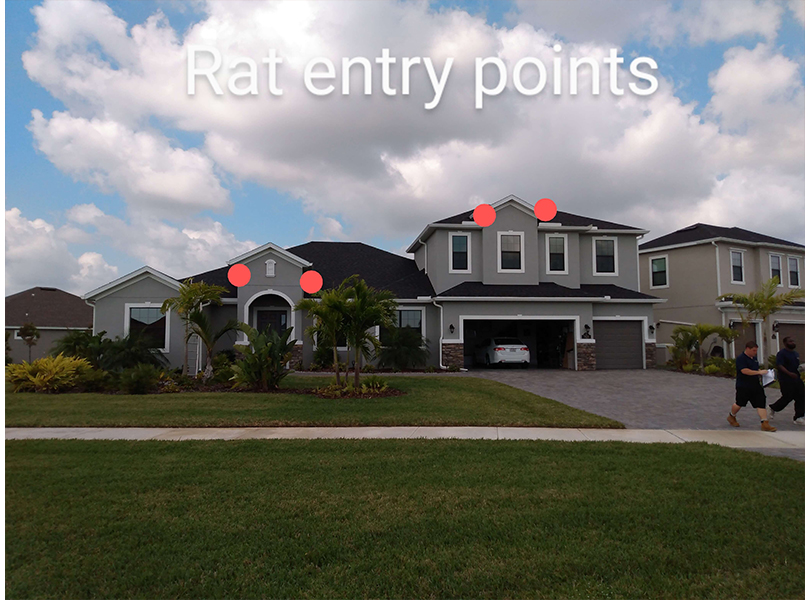Animals we find in the Attic
Every day in Brevard county we receive calls, emails and text from clients very anxious and upset because they hear noises in the ceiling, walls or attic.
The last thing anybody wants is to have rodents or wildlife running around up in their attic chewing their wires and ducts not to mention all the feces and urine that can be left behind to ruin your insulation.
Most people most people find out there’s something rooting around in their attic when they either hear the noises, go up inside the attic to get some holiday decorations or actually watch the critter entering somewhere on the roof or soffit.
From my 15 years experience in animal removal in Brevard county I’ve noticed it’s typically going to be rats, squirrels, raccoons or bats.

RATS
Let’s start with the first one: rats – whenever you have rats in your attic it’s going to be very obvious they are nocturnal animals so you’re going to hear most of your pitter-patter movement in the Attic at night typically when you’re laying in bed or sitting on the couch watching TV.
They’re also the easiest to identify up in the attic since they leave tunnels and droppings in the insulation and have very distinct urine smell. Rats can get down into your garage and chew into feed, plant food, fertilizers or whatever has an attractive smell to them.
Roof rats love to enter the attic through your soffit, ridge vents or any gap they can find on the building.

The worst part is you don’t even have to have a hole in your building they can make one by chewing through weak points. Ridding your attic of roof rats can be a pretty simple process if done right the first step is to perform an exclusion on the exterior of the building which means seal all of the holes the second step would be to set rat traps up in the attic “not mouse traps”!
The timeline for eliminating your attic of roof rats is different on every home you could catch all the rats in one night or it could take you weeks to months depending on the severity.
Once you’ve actually removed all of the rats from the attic you can perform an inspection to see if any insulation, wires or HVAC has been damaged.
You would obviously move on to any of those repairs once you’re fully confident you got all those pests out and they can’t get in ever again.
SQUIRRELS
The next critter we will talk about is the squirrel or a rat with a bushy tail.
I always find it very easy to identify squirrels because they tend to stay in the soffit area of the home and are not nocturnal and cause noises in the Attic mostly during the day, I like to say they’re on our clock.
When squirrels are nesting in your attic you tend to see them running all over the roof or on top of your screen enclosure.
The good part about squirrels versus rats is they don’t leave very many droppings in the attic and tend to have limited litters three to four babies in the fall or spring.
Traditional squirrel traps are not very effective when trying to remove squirrels from the attic or your yard since you’re competing with a lot of outside natural food sources.
Eliminating squirrels is a two-step process the first step we take we will go around the home and perform the exclusion seal up anywhere they can get in but we will not seal the main entry point because we will be placing a one-way door or a cone which allows the squirrels to exit the building but not re-enter.
The second step would be removing the squirrel exclusion device and sealing that last hole once you would complete this the problem would be solved. Once again want to go in your attic and just check to make sure no damage has been done to any wires or HVAC.

RACCOONS
The most stubborn and dangerous animal we deal with is the raccoon or as I would say the female raccoon because that’s the only raccoon you will get in the Attic just like squirrels the raccoon primarily nest in your attic because they’re having a litter of babies.
Raccoon noises in the Attic tend to be at night but you can also hear them during the day I always describe it as a slow moving almost dragging sound up in the attic and you can hear their claws on the drywall you can also see the female going in and out a couple times a day to get food and water.
The first thing people think to do when they have a raccoon living in their attic is to set a trap this is very ineffective and almost useless since the female will have no interest in the trap and if you do by luck catch her you could now be stuck with babies in an area you might not be able to get to. I would say 50% of the time customers have a raccoon in the Attic it’s not even living in the Attic it just broke through the soffit or the roof to investigate to see whether it wants to make it it’s den so a lot of times you want to monitor the hole and if it’s not active just repair it before she come back to make it her permanent residence. if it is active proceed with using a deterrent like a male raccoon hormone which is a natural predator to the female and the babies.
Raccoons tend to enter the Attic through a roof return or an area where the soffit meets your roof system that area tends to be weak and the raccoon is able to get leverage and just push it up or pull it apart to get in.
Once the raccoons are gone those areas need to be repaired with a flashing screwed and caulked.
Just repairing the soffit will not work the raccoon will come back and rip through it remember they leave pheromones.

BATS
Bats the most common flying pest that we get calls for.
Bats are easy to identify because you can see them flying in and out of your home early in the morning or late in the day.
They also leave an undescribable stench from their guano and pheromones.
When I get calls for bats in Brevard county I usually can find the entry point just walking up to the front door because you will see dark areas around the entry point and black guano all over the walls or walkway.
When a home has bats it’s typically in the front of the home because that’s where all your soffit returns are you can hear them squeaking you can also see the accumulation of guano and as I stated earlier the stench.
I would say most structures in Brevard county that get bats are multi-unit buildings because they are tall, tile roofs because they have many gaps for the bats colonies to live in and shingle roofs because they have typically multiple roof returns with openings into the Attic.
Ridding a home of bats is a 3 -step process the first step is what I like to call a pre-seal up that is where we go around and seal everything on the building that a bat could get in but we will not seal where the bats are using to go in and out.
The next step we will either apply a batnet or cone which will allow the bats to leave the building but not re-enter I guess you could say it tricks them out of the building because they use sonar.
The third and final step is simple after all of the bats have exited the structure you simply pull the netting or cone off and seal the last hole then you would obviously proceed with any type of cleanup which most of the time is needed.

